Abstract
A few animal studies on the possible carcinogenic effect of magnetic fields have been published. They have been designed to reveal a possible tumor promotion obtained by applying continuous or pulsed alternating fields at flux densities varying between 0.5 microT and 30 mT on mice or rats initiated with different initiators. One study with 2 mT applied on DMBA-initiated mice may suggest a copromotive effect together with the promoter TPA. Another study on rats suggests an inhibitory effect by a magnetic field on rat liver foci formation, induced with DENA. Cell studies show that magnetic fields at some frequencies, amplitudes, and wave forms interact with biological systems. Thus effects have been seen, e.g., on enzymes related to growth regulation, on calcium balance in the cell, on gene expression, and on pineal metabolism and its excretion of the oncostatic melatonin. Cellular and physiologic studies thus suggest effects that may be related to cell multiplication and tumor promotion.
Full text
PDF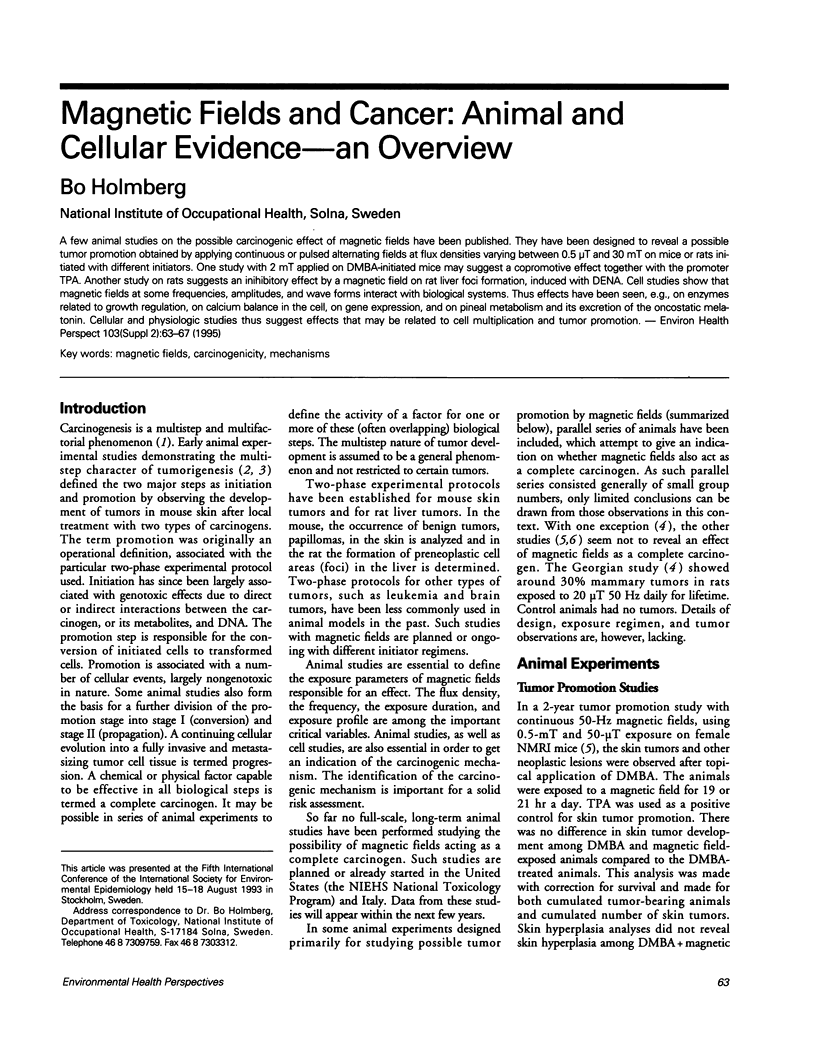
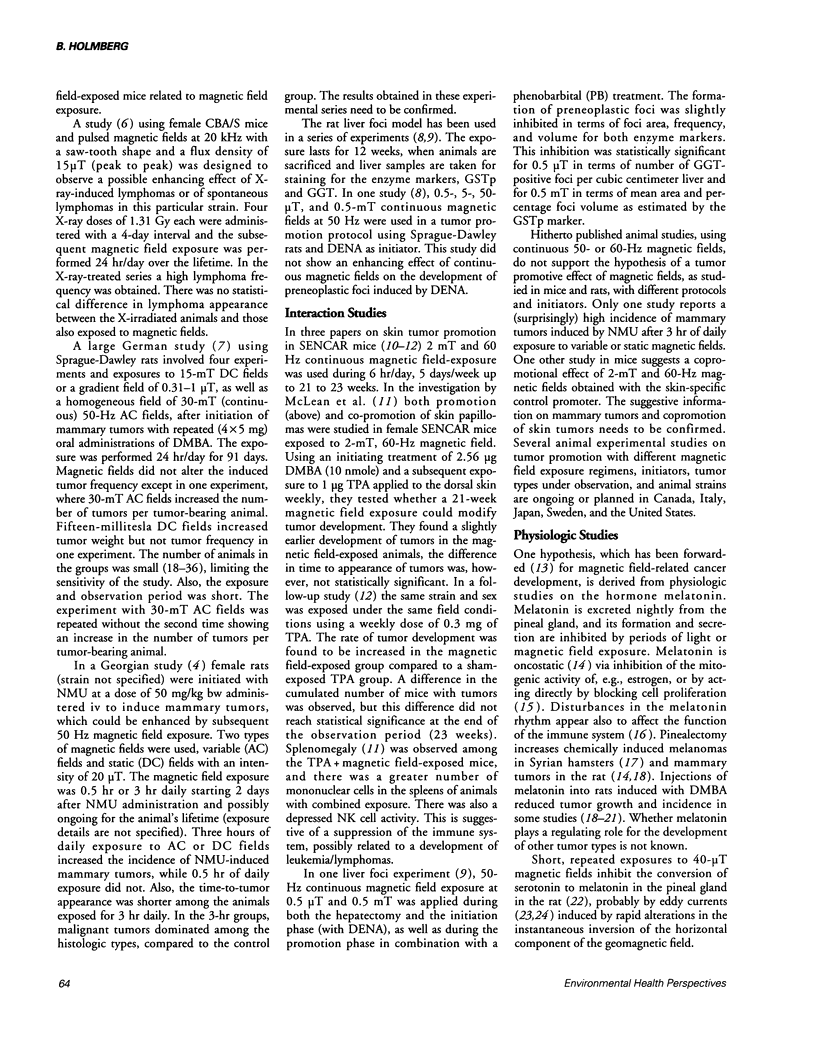
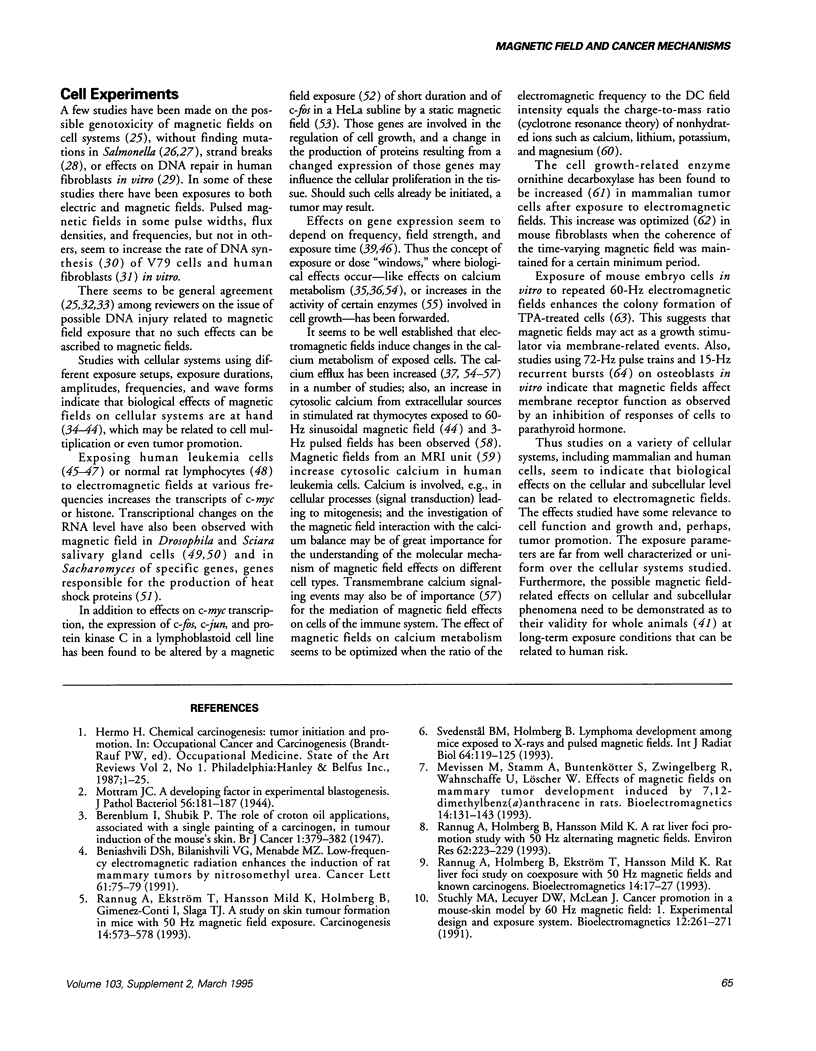
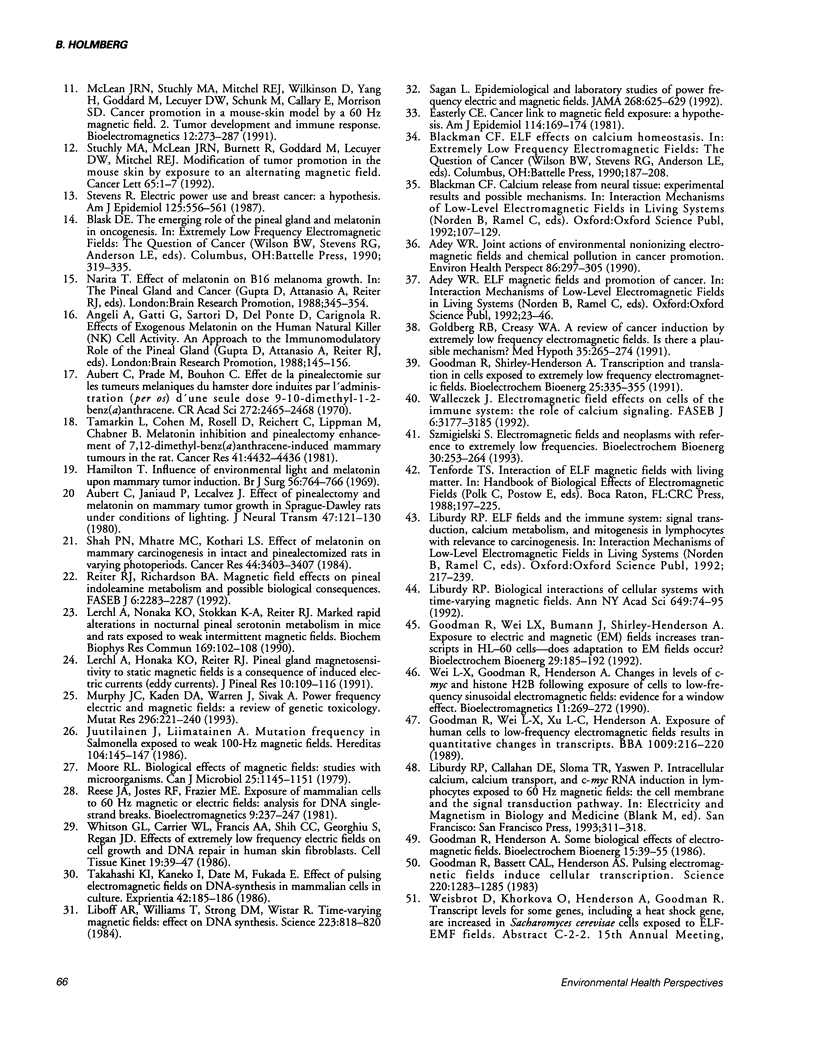
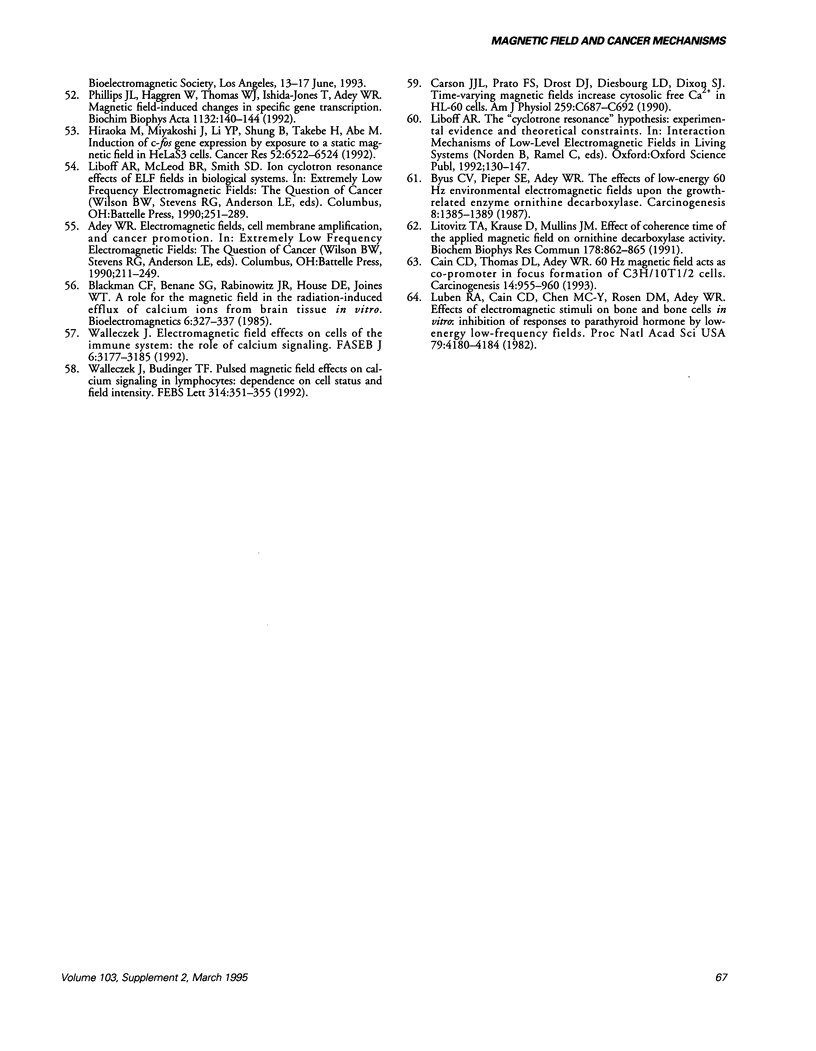
Selected References
These references are in PubMed. This may not be the complete list of references from this article.
- Adey W. R. Joint actions of environmental nonionizing electromagnetic fields and chemical pollution in cancer promotion. Environ Health Perspect. 1990 Jun;86:297–305. doi: 10.1289/ehp.9086297. [DOI] [PMC free article] [PubMed] [Google Scholar]
- Aubert C., Janiaud P., Lecalvez J. Effect of pinealectomy and melatonin on mammary tumor growth in Sprague-Dawley rats under different conditions of lighting. J Neural Transm. 1980;47(2):121–130. doi: 10.1007/BF01670163. [DOI] [PubMed] [Google Scholar]
- Aubert C., Prade M., Bohuon C. Effet de la pinéalectomie sur les tumeurs mélaniques du hamster doré induites ps l'administration (per os) d'une seule dose de 9,10-diméthyl-1,2-benzanthracène. C R Acad Sci Hebd Seances Acad Sci D. 1970 Dec 21;271(25):2465–2468. [PubMed] [Google Scholar]
- Beniashvili D. S., Bilanishvili V. G., Menabde M. Z. Low-frequency electromagnetic radiation enhances the induction of rat mammary tumors by nitrosomethyl urea. Cancer Lett. 1991 Dec 9;61(1):75–79. doi: 10.1016/0304-3835(91)90079-w. [DOI] [PubMed] [Google Scholar]
- Blackman C. F., Benane S. G., Rabinowitz J. R., House D. E., Joines W. T. A role for the magnetic field in the radiation-induced efflux of calcium ions from brain tissue in vitro. Bioelectromagnetics. 1985;6(4):327–337. doi: 10.1002/bem.2250060402. [DOI] [PubMed] [Google Scholar]
- Byus C. V., Pieper S. E., Adey W. R. The effects of low-energy 60-Hz environmental electromagnetic fields upon the growth-related enzyme ornithine decarboxylase. Carcinogenesis. 1987 Oct;8(10):1385–1389. doi: 10.1093/carcin/8.10.1385. [DOI] [PubMed] [Google Scholar]
- Cain C. D., Thomas D. L., Adey W. R. 60 Hz magnetic field acts as co-promoter in focus formation of C3H/10T1/2 cells. Carcinogenesis. 1993 May;14(5):955–960. doi: 10.1093/carcin/14.5.955. [DOI] [PubMed] [Google Scholar]
- Carson J. J., Prato F. S., Drost D. J., Diesbourg L. D., Dixon S. J. Time-varying magnetic fields increase cytosolic free Ca2+ in HL-60 cells. Am J Physiol. 1990 Oct;259(4 Pt 1):C687–C692. doi: 10.1152/ajpcell.1990.259.4.C687. [DOI] [PubMed] [Google Scholar]
- Easterly C. E. Cancer link to magnetic field exposure: a hypothesis. Am J Epidemiol. 1981 Aug;114(2):169–174. doi: 10.1093/oxfordjournals.aje.a113179. [DOI] [PubMed] [Google Scholar]
- Goldberg R. B., Creasey W. A. A review of cancer induction by extremely low frequency electromagnetic fields. Is there a plausible mechanism? Med Hypotheses. 1991 Jul;35(3):265–274. doi: 10.1016/0306-9877(91)90244-s. [DOI] [PubMed] [Google Scholar]
- Goodman R., Bassett C. A., Henderson A. S. Pulsing electromagnetic fields induce cellular transcription. Science. 1983 Jun 17;220(4603):1283–1285. doi: 10.1126/science.6857248. [DOI] [PubMed] [Google Scholar]
- Goodman R., Wei L. X., Xu J. C., Henderson A. Exposure of human cells to low-frequency electromagnetic fields results in quantitative changes in transcripts. Biochim Biophys Acta. 1989 Dec 22;1009(3):216–220. doi: 10.1016/0167-4781(89)90105-x. [DOI] [PubMed] [Google Scholar]
- Hamilton T. Influence of environmental light and melatonin upon mammary tumour induction. Br J Surg. 1969 Oct;56(10):764–766. doi: 10.1002/bjs.1800561018. [DOI] [PubMed] [Google Scholar]
- Hiraoka M., Miyakoshi J., Li Y. P., Shung B., Takebe H., Abe M. Induction of c-fos gene expression by exposure to a static magnetic field in HeLaS3 cells. Cancer Res. 1992 Dec 1;52(23):6522–6524. [PubMed] [Google Scholar]
- Juutilainen J., Liimatainen A. Mutation frequency in Salmonella exposed to weak 100-Hz magnetic fields. Hereditas. 1986;104(1):145–147. doi: 10.1111/j.1601-5223.1986.tb00527.x. [DOI] [PubMed] [Google Scholar]
- Lerchl A., Nonaka K. O., Reiter R. J. Pineal gland "magnetosensitivity" to static magnetic fields is a consequence of induced electric currents (eddy currents). J Pineal Res. 1991 Apr;10(3):109–116. doi: 10.1111/j.1600-079x.1991.tb00826.x. [DOI] [PubMed] [Google Scholar]
- Lerchl A., Nonaka K. O., Stokkan K. A., Reiter R. J. Marked rapid alterations in nocturnal pineal serotonin metabolism in mice and rats exposed to weak intermittent magnetic fields. Biochem Biophys Res Commun. 1990 May 31;169(1):102–108. doi: 10.1016/0006-291x(90)91439-y. [DOI] [PubMed] [Google Scholar]
- Liboff A. R., Williams T., Jr, Strong D. M., Wistar R., Jr Time-varying magnetic fields: effect on DNA synthesis. Science. 1984 Feb 24;223(4638):818–820. doi: 10.1126/science.6695183. [DOI] [PubMed] [Google Scholar]
- Liburdy R. P. Biological interactions of cellular systems with time-varying magnetic fields. Ann N Y Acad Sci. 1992 Mar 31;649:74–95. doi: 10.1111/j.1749-6632.1992.tb49599.x. [DOI] [PubMed] [Google Scholar]
- Litovitz T. A., Krause D., Mullins J. M. Effect of coherence time of the applied magnetic field on ornithine decarboxylase activity. Biochem Biophys Res Commun. 1991 Aug 15;178(3):862–865. doi: 10.1016/0006-291x(91)90970-i. [DOI] [PubMed] [Google Scholar]
- Luben R. A., Cain C. D., Chen M. C., Rosen D. M., Adey W. R. Effects of electromagnetic stimuli on bone and bone cells in vitro: inhibition of responses to parathyroid hormone by low-energy low-frequency fields. Proc Natl Acad Sci U S A. 1982 Jul;79(13):4180–4184. doi: 10.1073/pnas.79.13.4180. [DOI] [PMC free article] [PubMed] [Google Scholar]
- McLean J. R., Stuchly M. A., Mitchel R. E., Wilkinson D., Yang H., Goddard M., Lecuyer D. W., Schunk M., Callary E., Morrison D. Cancer promotion in a mouse-skin model by a 60-Hz magnetic field: II. Tumor development and immune response. Bioelectromagnetics. 1991;12(5):273–287. doi: 10.1002/bem.2250120503. [DOI] [PubMed] [Google Scholar]
- Mevissen M., Stamm A., Buntenkötter S., Zwingelberg R., Wahnschaffe U., Löscher W. Effects of magnetic fields on mammary tumor development induced by 7,12-dimethylbenz(a)anthracene in rats. Bioelectromagnetics. 1993;14(2):131–143. doi: 10.1002/bem.2250140206. [DOI] [PubMed] [Google Scholar]
- Moore R. L. Biological effects of magnetic fields: studies with microorganisms. Can J Microbiol. 1979 Oct;25(10):1145–1151. doi: 10.1139/m79-178. [DOI] [PubMed] [Google Scholar]
- Murphy J. C., Kaden D. A., Warren J., Sivak A. International Commission for Protection Against Environmental Mutagens and Carcinogens. Power frequency electric and magnetic fields: a review of genetic toxicology. Mutat Res. 1993 Mar;296(3):221–240. doi: 10.1016/0165-1110(93)90013-d. [DOI] [PubMed] [Google Scholar]
- Phillips J. L., Haggren W., Thomas W. J., Ishida-Jones T., Adey W. R. Magnetic field-induced changes in specific gene transcription. Biochim Biophys Acta. 1992 Sep 24;1132(2):140–144. doi: 10.1016/0167-4781(92)90004-j. [DOI] [PubMed] [Google Scholar]
- Rannug A., Ekström T., Mild K. H., Holmberg B., Gimenez-Conti I., Slaga T. J. A study on skin tumour formation in mice with 50 Hz magnetic field exposure. Carcinogenesis. 1993 Apr;14(4):573–578. doi: 10.1093/carcin/14.4.573. [DOI] [PubMed] [Google Scholar]
- Rannug A., Holmberg B., Ekström T., Mild K. H. Rat liver foci study on coexposure with 50 Hz magnetic fields and known carcinogens. Bioelectromagnetics. 1993;14(1):17–27. doi: 10.1002/bem.2250140105. [DOI] [PubMed] [Google Scholar]
- Rannug A., Holmberg B., Mild K. H. A rat liver foci promotion study with 50-Hz magnetic fields. Environ Res. 1993 Aug;62(2):223–229. doi: 10.1006/enrs.1993.1107. [DOI] [PubMed] [Google Scholar]
- Reese J. A., Jostes R. F., Frazier M. E. Exposure of mammalian cells to 60-Hz magnetic or electric fields: analysis for DNA single-strand breaks. Bioelectromagnetics. 1988;9(3):237–247. doi: 10.1002/bem.2250090305. [DOI] [PubMed] [Google Scholar]
- Reiter R. J., Richardson B. A. Magnetic field effects on pineal indoleamine metabolism and possible biological consequences. FASEB J. 1992 Mar;6(6):2283–2287. doi: 10.1096/fasebj.6.6.1544540. [DOI] [PubMed] [Google Scholar]
- Sagan L. A. Epidemiological and laboratory studies of power frequency electric and magnetic fields. JAMA. 1992 Aug 5;268(5):625–629. [PubMed] [Google Scholar]
- Shah P. N., Mhatre M. C., Kothari L. S. Effect of melatonin on mammary carcinogenesis in intact and pinealectomized rats in varying photoperiods. Cancer Res. 1984 Aug;44(8):3403–3407. [PubMed] [Google Scholar]
- Stevens R. G. Electric power use and breast cancer: a hypothesis. Am J Epidemiol. 1987 Apr;125(4):556–561. doi: 10.1093/oxfordjournals.aje.a114569. [DOI] [PubMed] [Google Scholar]
- Stuchly M. A., Lecuyer D. W., McLean J. Cancer promotion in a mouse-skin model by a 60-Hz magnetic field: I. Experimental design and exposure system. Bioelectromagnetics. 1991;12(5):261–271. doi: 10.1002/bem.2250120502. [DOI] [PubMed] [Google Scholar]
- Stuchly M. A., McLean J. R., Burnett R., Goddard M., Lecuyer D. W., Mitchel R. E. Modification of tumor promotion in the mouse skin by exposure to an alternating magnetic field. Cancer Lett. 1992 Jul 31;65(1):1–7. doi: 10.1016/0304-3835(92)90205-a. [DOI] [PubMed] [Google Scholar]
- Svedenstål B. M., Holmberg B. Lymphoma development among mice exposed to X-rays and pulsed magnetic fields. Int J Radiat Biol. 1993 Jul;64(1):119–125. doi: 10.1080/09553009314551171. [DOI] [PubMed] [Google Scholar]
- Takahashi K., Kaneko I., Date M., Fukada E. Effect of pulsing electromagnetic fields on DNA synthesis in mammalian cells in culture. Experientia. 1986 Feb 15;42(2):185–186. doi: 10.1007/BF01952459. [DOI] [PubMed] [Google Scholar]
- Tamarkin L., Cohen M., Roselle D., Reichert C., Lippman M., Chabner B. Melatonin inhibition and pinealectomy enhancement of 7,12-dimethylbenz(a)anthracene-induced mammary tumors in the rat. Cancer Res. 1981 Nov;41(11 Pt 1):4432–4436. [PubMed] [Google Scholar]
- Walleczek J., Budinger T. F. Pulsed magnetic field effects on calcium signaling in lymphocytes: dependence on cell status and field intensity. FEBS Lett. 1992 Dec 21;314(3):351–355. doi: 10.1016/0014-5793(92)81504-f. [DOI] [PubMed] [Google Scholar]
- Walleczek J. Electromagnetic field effects on cells of the immune system: the role of calcium signaling. FASEB J. 1992 Oct;6(13):3177–3185. doi: 10.1096/fasebj.6.13.1397839. [DOI] [PubMed] [Google Scholar]
- Walleczek J. Electromagnetic field effects on cells of the immune system: the role of calcium signaling. FASEB J. 1992 Oct;6(13):3177–3185. doi: 10.1096/fasebj.6.13.1397839. [DOI] [PubMed] [Google Scholar]
- Wei L. X., Goodman R., Henderson A. Changes in levels of c-myc and histone H2B following exposure of cells to low-frequency sinusoidal electromagnetic fields: evidence for a window effect. Bioelectromagnetics. 1990;11(4):269–272. doi: 10.1002/bem.2250110403. [DOI] [PubMed] [Google Scholar]
- Whitson G. L., Carrier W. L., Francis A. A., Shih C. C., Georghiou S., Regan J. D. Effects of extremely low frequency (ELF) electric fields on cell growth and DNA repair in human skin fibroblasts. Cell Tissue Kinet. 1986 Jan;19(1):39–47. doi: 10.1111/j.1365-2184.1986.tb00713.x. [DOI] [PubMed] [Google Scholar]


